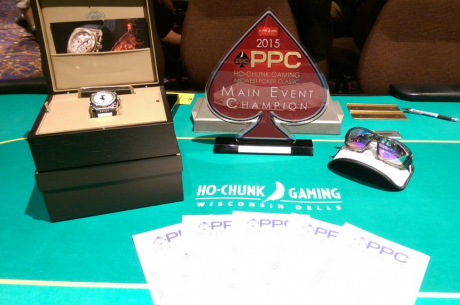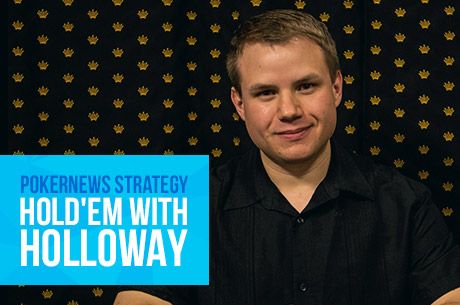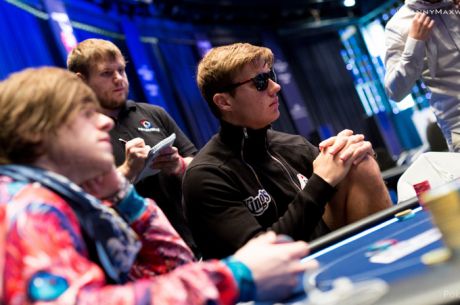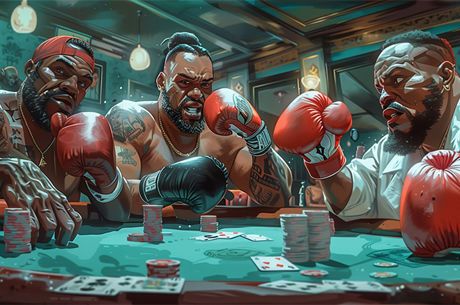Hold’em with Holloway, Vol. 41: Analyzing a Questionable SHRPO Main Event Hand
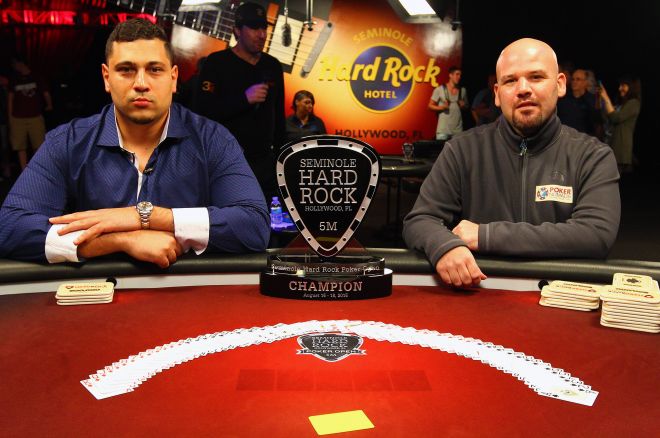
On Tuesday, I took the opportunity to watch the Seminole Hard Rock and Poker Night in America’s live stream of four final tables from the Seminole Hard Rock Poker Open (SHRPO), which included the final table of the $5,250 buy-in $5,000,000 guaranteed No-Limit Hold’em Championship, a tournament that had a slight overlay as it attracted 907 players, 93 players shy of meeting the guarantee.
Omar Zazay ended up capturing the $1,000,000 first-place prize after defeating local poker dealer Brian Phillis in an epic heads-up battle. What’s more, the duo managed to outlast the defending champion, Daniel Colman, who saw his title defense come to an end in third place for $310,000. For a full recap of that event, click here.
I was actually surprised to see Zazay and Phillis make it to heads-up play. As I was watching, the two played a big pot with eight players remaining, one that could very well have resulted in an elimination. Instead, it played out a bit differently — and strangely.
I thought I’d examine the hand in question in this week’s Hold’em With Holloway by breaking it down street by street and offering my take on each.
Preflop
The hand took place in Level 27 (40,000/80,000/10,000) with eight players remaining. On Hand #27, Zazay, who was sitting with roughly 3.7 million in chips, opened for 180,000 from the button holding A♥Q♣. Phillis, who was sitting with approximately 3.5 million, opted to defend from the big blind with 7♣5♣.
My Take: Nothing special yet. Most players would open the button with a wide range of hands, but in this case Zazay has a legitimately strong one. Of course Phillis doesn’t know this. Had he woken up with a hand like Ax10x or better a three-bet could have been in order, but as it was he picked up suited one-gappers and decided to see a flop.
I actually like Phillis’ decision to call from the big blind. I’m a big fan of such hands because they tend to make things easy — either you flop something strong and play a big pot, or you don’t and ditch it without further investment. Plus, in this hand, Phillis was already in for 80,000, so it was just a bit more than a min-raise to see a flop.
According to the PokerNews Odds Calculator, Zazay was a 60.56% favorite at this point, while Phillis would win 38.93% of the time.
The Flop
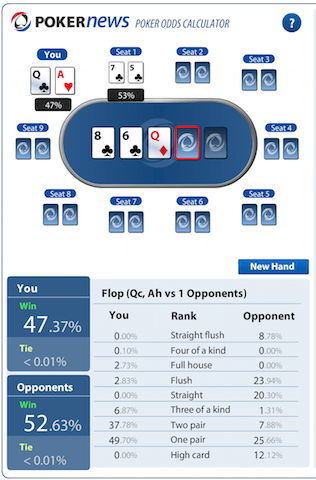
The 8♣6♣Q♦ flop had action written all over it. Phillis flopped an open-ended straight flush draw, which actually made him a 52.63% favorite. Meanwhile, Zazay had flopped top pair with top kicker, giving him a 47.37% chance of winning the pot. Phillis coyly checked, Zazay bet 200,000, and Phillis took his time before min-raising to 400,000. Zazay thought for a bit before reraising to 650,000, and Phillis once again hit the tank before making the call.
My Take: I love Phillis’ check on the flop. Most players are going to continuation bet in position, which is just what Zazay did for a little less than half the pot. I like the sizing as it’ll entice draws and most hands with a queen, eight, or six.
If I’m in Phillis’ shoes, I’m check-raising the flop 100% of the time. Even if my opponent flopped a set of queens — the nuts at that point — I’ve still got a 40.61% chance of winning the pot. And if he has a better flush draw, let’s say the A♣Q♣ for a pair and flush draw, I’ve still got a 31.21% chance of winning. So even in the two worst-case scenarios I’m drawing very much alive. Plus, a check-raise may result in a fold, which isn’t a bad result as I haven’t made my hand yet.
While I was glad to see Phillis check-raise, his sizing was terrible. Min-raising screamed of weakness and priced in any hand that caught a piece of the flop. Given he was out of position without a made hand, I’d have much rather seen him make it roughly 600,000. Soliciting a fold would be great, but getting chips in the pot in anticipation of making your hand also isn’t bad. Phillis’ move wasn’t going to result in either.
At that point Zazay three-bet to 650,000. Again, I’m not crazy about the sizing. Sure, you don’t want to scare off worse queens, say a KxQx or QxJx, or smaller pairs, but you also don’t want to price in draws. By making it just 250,000 more, Zazay was not only giving Phillis great odds to call, but opened the door for further action. If I were in his shoes, I would have bumped it to a million or so. That would have put Phillis in a much tougher spot.
I wouldn’t have been surprised to see Phillis shove all in; in fact, that’s probably what I’d have done in his shoes. Given the way things played out, I would have put my opponent on either a bluff, queens with a good kicker, or a flush draw. By moving all in I’d get a fold from a bluff, and could very well push out the other two hands. Even if my opponent calls, I’m drawing very much live.
Instead, Phillis just called, which basically turned his hand face up. At that point Zazay knew Phillis either held an inferior queen, or much more likely a draw of some sort.
The Turn
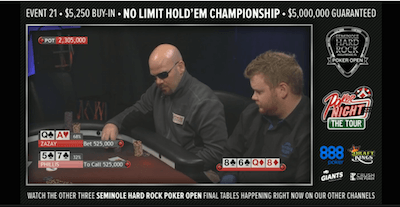
The dealer burned and turned the 8♦, which paired the board. Phillis checked, Zazay bet 525,000, and Phillis tank-called.
My Take: After taking the line he did on the flop, Phillis was wise to check, especially with the paired board. Zazay was also wise to bet, but not the amount he chose. The way the hand unfolded suggested Phillis held a draw, so by betting just 525,000 into a pot of roughly 1.7 million, Zazay was giving his opponent great odds to draw. Phillis had to love the price and promptly put in the chips.
Had it been me, I’d have bet closer to 1.1 million, give or take.
The River
The 10♠ blanked on the river and action went check-check. Zazay tabled the winner to chip up to 5.33 million, and Phillis showed his hand before dropping down to 2.135 million.
My Take: Phillis was correct to check yet again. He paid to see the river, which wasn’t a scare card, so a steal attempt would have been suspicious. It was time for him to give up on the hand, which he did.
As for Zazay, his check isn’t terrible (he’d have been hard pressed if Phillis check-raised all in), but I would have went for value, say 800,000 or so. If Phillis missed his draw, he’d fold, which would result in the same outcome as checking. However, if he had a hand like QxJx of KxQx, there’s a good chance he’d pay it off.
The hand could have played out many different ways, but in this instance neither player lost nor won as much as they could have. To be honest, I didn’t think either player had a shot of going far after watching that hand, but they both proved me wrong. Being results oriented it worked out for both players. Had Phillis gotten aggressive with his straight flush, he’d likely have $475,000 less in his pocket (the difference between second and eighth place).
What are your thoughts? How would you have played the hand had you been in Phillis’ shoes? How about Zazay’s? Let me know in the comments section or by reaching out on Twitter @ChadAHolloway.
*Lead photo courtesy of SHRPO Blog.
Want to stay atop all the latest in the poker world? If so, make sure to get PokerNews updates on your social media outlets. Follow us on Twitter and find us on both Facebook and Google+!
In this Series
- 1 Hold’em with Holloway, Vol. 1: Making Reads and Trusting Them
- 2 Hold’em with Holloway, Vol. 2: Playing in Poker Charity Events
- 3 Hold’em with Holloway, Vol. 3: Throttle Back Before You End Up Punting
- 4 Hold’em with Holloway, Vol. 4: Punish the Satellite Bubble
- 5 Hold’em with Holloway, Vol. 5: What is Proper Accumulator Strategy?
- 6 Hold’em with Holloway, Vol. 6: A Chip and a Chair Story with “SirWatts”
- 7 Hold’em with Holloway, Vol. 7: 15 Things About Poker I Wish I’d Known Sooner
- 8 Hold’em with Holloway, Vol. 8: Examining the Largest Overlay in Poker History
- 9 Hold’em with Holloway, Vol. 9: Differences Between Rebuys and Reentries
- 10 Hold’em with Holloway, Vol. 10: Five Must-Read Poker Books of 2014
- 11 Hold’em with Holloway, Vol. 11: When Will You Finally Break Through?
- 12 Hold’em with Holloway, Vol. 12: Dealing with a Target on Your Back
- 13 Hold’em with Holloway, Vol. 13: Knowing When to Call It Quits
- 14 Hold’em with Holloway, Vol. 14: Embarking on a Year-Long Weight Loss Journey
- 15 Hold’em with Holloway, Vol. 15: Navigating Multiple Decision Points in a Poker Hand
- 16 Hold’em with Holloway, Vol. 16: Chris Moorman Tells Me How Badly I Play Poker
- 17 Hold’em with Holloway, Vol. 17: Richard “nutsinho” Lyndaker on Getting It in Marginal
- 18 Hold’em with Holloway, Vol. 18: Getting Inside the Head of Poker Pro Brian Rast
- 19 Hold’em with Holloway, Vol. 19: Stupid Calls & Lucky Draws in MSPT WI Championship
- 20 Hold’em with Holloway, Vol. 20: Talking Ante-Only Strategy with Greg “FossilMan” Raymer
- 21 Hold’em with Holloway, Vol. 21: Contributing to Jonathan Little’s New Book
- 22 Hold’em with Holloway, Vol. 22: Consequences of Acting Out of Turn & Tossing in Chips
- 23 Hold’em with Holloway, Vol. 23: When It Comes to Chops, Do What’s In Your Best Interest
- 24 Hold’em with Holloway, Vol. 24: Accepting Bad Beats & Lessons in Selling Action
- 25 Hold’em with Holloway, Vol. 25: Heinz’ Ace-High Call Shows Why He's a World Champ
- 26 Hold’em with Holloway, Vol. 26: Is Keeping the Short Stack Alive Collusion?
- 27 Hold’em with Holloway, Vol. 27: Great Laydown or Bad Fold on Poker Night in America?
- 28 Hold’em with Holloway, Vol. 28: Calling Hellmuth with Jack-Deuce Offsuit
- 29 Hold’em with Holloway, Vol. 29: The Philosophy of "No-Chop" Chad
- 30 Hold’em with Holloway, Vol. 30: Preparing to Play the World Series of Poker
- 31 Hold’em with Holloway, Vol. 31: Staying on Your Grind at the World Series of Poker
- 32 Hold’em with Holloway, Vol. 32: The Perilous Decision to Call Off with Ace-Queen
- 33 Hold’em with Holloway, Vol. 33: Using Poker Skills in Reality TV Competitions
- 34 Hold’em with Holloway, Vol. 34: Esfandiari Explains How to Recover from Bad Beats
- 35 Hold’em with Holloway, Vol. 35: Tilly vs. Brunson in Super High Roller Cash Game Hand
- 36 Hold’em with Holloway, Vol 36: Unconventional Play Leads to Good WSOP Main Event Start
- 37 Hold’em with Holloway, Vol. 37: Lessons in Pot-Limit Omaha Hi-Low w/ Evan Jarvis
- 38 Hold’em with Holloway, Vol. 38: Things to Say and Do When You Bust a Poker Tournament
- 39 Hold’em with Holloway, Vol. 39: How Much Did I Have to Raise to Get You to Fold?
- 40 Hold’em with Holloway, Vol. 40: Practicing Patience in My Deep PPC Poker Tour Run
- 41 Hold’em with Holloway, Vol. 41: Analyzing a Questionable SHRPO Main Event Hand
- 42 Hold’em with Holloway, Vol. 42: Analyzing the Play of Neymar Jr. at EPT Barcelona
- 43 Hold’em with Holloway, Vol. 43: The Value of a Reliable Poker Reputation
- 44 Hold’em with Holloway, Vol. 44: John “KasinoKrime” Beauprez Rips My PLO Game Apart
- 45 Hold’em with Holloway, Vol. 45: Satellite Dilemmas -- To Call or Not to Call
- 46 Hold’em with Holloway, Vol. 46: Seiver Leverages the River in Super High Roller Bowl
- 47 Hold’em with Holloway, Vol. 47: What Untraditional Moves in Poker Might Mean
- 48 Hold’em with Holloway, Vol. 48: Thinking About the Future with Sam Grizzle
- 49 Hold’em with Holloway, Vol. 49: WCOOP Champ “Coenaldinho7” Offers Up His Biggest Hands
- 50 Hold’em with Holloway, Vol. 50: The Peril of Shoving Weak Aces
- 51 Hold’em with Holloway, Vol. 51: The Importance of Not Giving Up in Poker Tournaments
- 52 Hold’em with Holloway, Vol. 52: Does Asking “Check” Actually Constitute a Check?
- 53 Hold’em with Holloway, Vol. 53: Thomas Cannuli Impresses Even After Main Event Bustout
- 54 Hold’em with Holloway, Vol. 54: Dealers Aren’t Always Right
- 55 Hold’em with Holloway, Vol. 55: Don’t Get Married to Pocket Aces
- 56 Hold’em with Holloway, Vol. 56: Bazeley’s Survival Instinct Leads to Continued Success
- 57 Hold’em with Holloway, Vol. 57: Playing “Deuces Wild” on the European Poker Tour
- 58 Hold’em with Holloway, Vol. 58: The Wildest Hand in European Poker Tour History
- 59 Hold’em with Holloway, Vol. 59: Death, Zombies & Spending Time w/Phil Hellmuth
- 60 Hold’em with Holloway, Vol. 60: How the Unstoppable Fedor Holz Managed to Win Again
- 61 Hold’em with Holloway, Vol. 61: Lessons To Be Learned When You Hit the Big Stage
- 62 Hold’em with Holloway, Vol. 62: Steve O’Dwyer Explains the “Oreo Cookie Tell”
- 63 Hold’em with Holloway, Vol. 63: What Would Happen to a Chip Stack If a November Niner Died?
- 64 Hold’em with Holloway, Vol. 64: Forgetting One Chip -- Should It Still Be an All-In Bet?
- 65 Hold’em with Holloway, Vol. 65: Todd “sharkslayerrr” Breyfogle on Bankroll Management
- 66 Hold’em with Holloway, Vol. 66: Cash Game Pro Daniel Arfin Offers Sound Bankroll Advice
- 67 Hold’em with Holloway, Vol. 67: Honeyman Plays Kings to Keep in Opponent’s Bluff Range
- 68 Hold’em with Holloway, Vol. 68: Why Do I Even Bother Drinking at the Poker Table?
- 69 Hold’em with Holloway, Vol. 69: Is Your Favorite Poker Pro Left- or Right-Handed?
- 70 Hold’em with Holloway, Vol. 70: In Order to Live You Have to Be Willing to Die
- 71 Hold’em with Holloway, Vol. 71: How to Amass a Big Stack Early in a Poker Tournament
- 72 Hold’em with Holloway, Vol. 72: Answering User-Submitted Poker Scenarios
- 73 Hold’em with Holloway, Vol. 73: Saying Goodbye with a Top Five List
- 74 Hold'em with Holloway, Vol. 74: We're Back, Baby!
- 75 Hold'em with Holloway, Vol. 75: Jivkov on Exploiting Capped Ranges
- 76 Hold’em with Holloway, Vol. 76: Matt Bretzfield Gets Tricky With Aces
- 77 Hold'em with Holloway, Vol. 77: Joseph Cheong Gets Crazy with a Pair of Ladies
- 78 Hold'em with Holloway, Vol. 78: Wyoming Poker Action & Wild South Dakota Hand
- 79 Hold'em with Holloway, Vol. 79: Calling Controversy at WinStar
- 80 Hold'em with Holloway, Vol. 80: Going for Value with Matt Hunt
- 81 Hold'em with Holloway, Vol. 81: Bracelet Winner Ryan Leng on Bad Call
- 82 Hold'em with Holloway, Vol. 82: Romeopro33 Recounts XL Eclipse Victory
- 83 Hold'em with Holloway, Vol. 83: Men The Master Doesn't Get Paid
- 84 Hold'em with Holloway, Vol. 84: Harman Hits Back-to-Back Miracle Turns
- 85 Hold'em with Holloway, Vol. 85: Jamie Kerstetter on Dealing with Bounties
- 86 Hold'em with Holloway, Vol. 86: Matt Stout Develops a Limp Dynamic
- 87 Hold'em with Holloway, Vol. 87: Matt Alexander Caught in Between w/ Two Red Aces
- 88 Hold'em with Holloway, Vol. 88: John Beauprez on Why He Folded a Set of Jacks
- 89 Hold'em with Holloway, Vol. 89: Alex Aqel Lets Opponent Hang Himself with Aces
- 90 Hold'em with Holloway, Vol. 90: David Peters Makes Beastly Call Against Will Givens
- 91 Hold'em with Holloway, Vol. 91: Poker Lessons from a Game of Risk
- 92 Hold'em with Holloway, Vol. 92: My Upstuck Diagnosis by the CLC Squad
- 93 Hold'em with Holloway, Vol. 93: Alex Foxen Coolers Nick Petrangelo in SHRB
- 94 Hold'em with Holloway, Vol. 94: My $25,000 PSPC Experience at 2019 PCA
- 95 Hold'em with Holloway, Vol. 95: The Equity of Leveraging Time Extensions
- 96 Hold'em with Holloway, Vol. 96: Dan O'Brien on Developing Healthy Routines
- 97 Hold'em with Holloway, Vol. 97: Big Hands From the WSOP-C Potawatomi
- 98 Hold'em with Holloway, Vol. 98: Simon Deadman Rips Apart My NLH Tourney Play
- 99 Hold'em with Holloway, Vol. 99: Shoving 10-6 Smack Dab Into Pocket Aces
- 100 Hold'em with Holloway, Vol. 100: The Revived Re-Entries Debate

